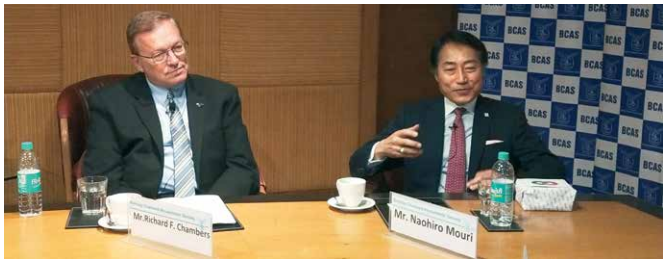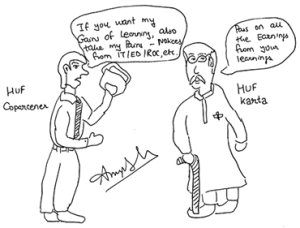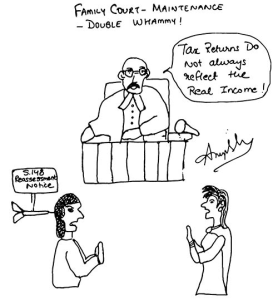INTRODUCTION
“Everything is worth what its purchaser will pay for it”
– Publilus Syrus’ Maxim No. 847
One of the most important roles of the Board of Directors of a listed company and its Audit Committee is the review and approval of Related Party Transactions (RPTs). Related Party Transactions are prescribed under s.188 of the Companies Act, 2013 (“Act”) as well as the SEBI (Listing Obligations and Disclosure Requirements)Regulations, 2015 (“SEBI LODR”). The most crucial element in approving an RPT is determining whether the transaction is on an arms’ length pricing (ALP)? Let us examine some key facets in this respect.
STATUTORY FRAMEWORK
Regulation 2(zc) of the SEBI LODR defines a related party transaction to mean a transaction involving a transfer of resources, services or obligations between a listed entity on one hand and a related party of the listed entity on the other hand, regardless of whether a price is charged and a “transaction” with a related party shall be construed to include a single transaction or a group of transactions in a contract.
Under Regulation 23(2) of the SEBI LODR, all related party transactions and subsequent material modifications, shall require prior approval of the Audit Committee of the listed entity.
S.188 of the Companies Act, 2013 provides that all related party transactions require the approval of the Board of Directors if they are not on an arms’ length basis. The expression “arm’s length transaction” has been defined to mean a transaction between two related parties that is conducted as if they were unrelated, so that there is no conflict of interest.
The Act / SEBI LODR does not provide any further guidance on this expression. Hence, one may refer to other statutes.
DICTIONARY DEFINITIONS
Various Dictionaries have defined the term arm’s length transaction as follows:
(a) The Black’s Law Dictionary, 6th Edition, defines it to mean a transaction negotiated by unrelated parties, each acting in its own self-interest; the basis for a fair market value determination.
(b) The Shorter Oxford English Dictionary, 5th Edition defines it as dealings between two parties where neither party is controlled by the other.
(c) Merriam-Webster’s 11th Collegiate Dictionary states that arm’s length is the condition or fact that the parties to a transaction are independent and on an equal footing.
(d) The Judicial Dictionary by KJ Aiyar, 13th Edition, states that arm’s length transaction is a transaction between unrelated persons in which there is no improper influence exercisable by one party over another and no conflict of interests.
ALP UNDER INCOME-TAX ACT, 1961
The expression “arm’s length price” features prominently in sections 92-92F of the Income-tax Act, 1961 in relation to transfer pricing provisions.
S.92C of this Act deals with the computation of an arm’s length price. It states that the arm’s length price in relation to a transaction shall be determined by any of the following methods, being the most appropriate method, having regard to the nature of transaction or class of transaction or class of associated persons or functions performed by such persons or such other relevant factors.
The methods prescribed under this section to determine ALP are: —
(a) comparable uncontrolled price method;
(b) resale price method;
(c) cost plus method;
(d) profit split method;
(e) transactional net margin method;
The Chennai ITAT in the case of Iljin Automotive Private Ltd vs. ACIT, (2011) 16 taxmann.com 225 has defined ALP as “What would have been the price if the transactions were between two unrelated parties, similarly placed as the related parties in so far as nature of product, conditions and terms and conditions of the transactions are concerned?”
In Arvind Mills Ltd. vs. ACIT [2011] 11 taxmann.com 67 (Ahd. – ITAT), it was held that the arm’s length principle is based on:
(i) a comparison of the conditions in a controlled transaction with the conditions in transaction between two independent enterprises i.e. uncontrolled transaction,
(ii) subject to adjustments to the price of uncontrolled transaction to carve out differences between these two type of transactions.
Hence, locating proper comparables i.e. comparable uncontrolled transactions is at the heart of an ALP.
Paragraph 1 of Article 9 of the OECD’s Model Tax Convention (which is the basis of bilateral tax treaties) provides as follows:
“(where) conditions are made or imposed between the two enterprises in their commercial or financial relations which differ from those which would be made between independent enterprises, then any profits which would, but for those conditions, have accrued to one of the enterprises, but, by reason of those conditions, have not so accrued, may be included in the profits of that enterprise and taxed accordingly”
In Dy. CIT vs. Smt. Baljinder Kaur [2009] 29 SOT 9 (URO), the Chandigarh ITAT held that it was a well settled proposition that the concept of ‘fair market value’ envisaged under the Income-tax Act existence of a hypothetical seller and a hypothetical buyer, in a hypothetical market.
CUP METHOD
The Comparable Uncontrolled Price Method (“CUP method”) is the most direct assessment of whether the arm’s length principle is complied with as it compares the price or value of the transactions. As it is the most direct method, it should, be preferred to the other methods. Under the CUP method, the arm’s length price of an RPT is equal to the price paid in comparable uncontrolled sales including adjustments, if any.
In the case of M/s. Schutz Dishman Biotech Pvt. Ltd., Ahmedabad, ITA 554 / AHD / 2006, the Ahmedabad ITAT held that the CUP method is the most suitable method for determining ALP if market conditions in the territory of sale are the same.
Rule 10B of the Income-tax Rules, 1962 states that in determining the ALP, the comparable uncontrolled price method is a method, by which the price charged or paid for property transferred or services provided in a comparable uncontrolled transaction, or a number of such transactions, is identified. Thus, the steps for determining ALP are as follows:
(i) Identify the price charged or paid for property transferred or services provided in a comparable uncontrolled transaction or a number of such transactions.
(ii) Adjust such price for differences, if any, between the RPT and the comparable uncontrollable transactions. Adjustments required only if these could materially affect the price in open market.
The adjusted price arrived at in (ii) above is to be taken as the arm’s length price.
According to Rule 10A(ab), “uncontrolled transaction” means a transaction between enterprises other than associated enterprises or related parties. For instance, A and B are related parties. C and D are independent parties (non-related). A transaction between C and D is an uncontrolled transaction as both A and B are concerned. A transaction between A and C/A and D is an uncontrolled transaction as far as B is concerned. A transaction between B and C/B and D is an uncontrolled transaction as far as A is concerned.
The Rule further states that the comparability of a transaction with an uncontrolled transaction shall be judged with reference to the following, namely:-
(a) the specific characteristics of the property transferred or services provided in either transaction;
(b) the functions performed, taking into account assets employed or to be employed and the risks assumed, by the respective parties to the transactions;
(c) the contractual terms (whether or not such terms are formal or in writing) of the transactions which lay down explicitly or implicitly how the responsibilities, risks and benefits are to be divided between the respective parties to the transactions;
(d) conditions prevailing in the markets in which the respective parties to the transactions operate, including the geographical location and size of the markets, the laws and Government orders in force, costs of labour and capital in the markets, overall economic development and level of competition and whether the markets are wholesale or retail.
An uncontrolled transaction shall be comparable to an RPT if —
(i) none of the differences, if any, between the transactions being compared are likely to materially affect the price or cost charged or paid in, or the profit arising from, such transactions in the open market; or
(ii) reasonably accurate adjustments can be made to eliminate the material effects of such differences.
In this respect, the United Nations Transfer Pricing Manual defines ‘comparable’ as under:
- To be comparable does not mean that the two transactions are necessarily identical.
- Instead it means that either none of the differences between them could materially affect the arm’s length price or profit or, where such material differences exist, that reasonably accurate adjustments can be made to eliminate their effect.
- Thus, in determining a reasonable degree of comparability, adjustments may need to be made to account for certain material differences between the controlled and uncontrolled transactions.
- These adjustments (which are referred to as “comparability adjustments”) are to be made only if the effect of the material differences on price or profits can be ascertained with sufficient accuracy to improve the reliability of the results.
The UN TP Manual also recognises that perfect comparables are often not available in an imperfect world. It is therefore necessary to use a practical approach to establish the degree of comparability between controlled and uncontrolled transactions.
Comparable uncontrollable transactions are of two types:
♦ Internalcomparables – transactions entered into by related parties with unrelated parties. To be considered as an internal CUP also, a transaction has to be an independent transaction, i.e., between two entities, which are independent of each other – Skoda Auto India (P.) Ltd. vs. Asst. CIT [2009] 30 SOT 319 (Pune – Trib.)
♦ External comparables – transactions between third parties (i.e. transactions not involving any related party).
According to the OECD Guidelines, internal comparables would provide more reliable and accurate data than external comparables. This is because external comparables are difficult to obtain, incomplete and difficult to interpret. Hence, internal comparables are to be preferred over external comparables.
VALUATION UNDER THE CENTRAL EXCISE LAW
The concept of valuation in case of a related person also finds mention under the Central Excise Act. In this respect, the decision of the Supreme Court in the case of CCE vs. Detergents India P Ltd, (2015) AIR SCW 3304 is relevant:
“……transactions at arm’s length between manufacturer and wholesale purchaser which yield the price which is the sole consideration for the sale alone is contemplated. Any concessional or manipulative considerations which depress price below the normal price are, therefore, not to be taken into consideration. Judged at from this premise, it is clear that arrangements with related persons which yield a price below the normal price because of concessional or manipulative considerations cannot ever be equated to normal price. But at the same time, it must be remembered that absent concessional or manipulative considerations, where a sale is between a manufacturer and a related person in the course of wholesale trade, the transaction being a transaction where it is proved by evidence that price is the sole consideration for the sale, then such price must form the basis for valuation as the “normal price” of the goods………………”
Thus, as long as an unrelated price is comparable to a related party price, the related party price has been treated as a normal sale price.
VALUATION UNDER GST LAWS
The GST Laws also provide for determination of open market value in certain cases. For levying GST only that value should be used which is that of an unrelated buyer and supplier. The Central Goods and Services Tax (CGST) Rules, 2017 specify that the value of the supply of goods or services or both between related parties shall be the open market value of such supply.
The term “open market value” of a supply of goods or services or both has been defined to mean the full value in money, excluding GST payable by a person in a transaction, where the supplier and the recipient of the supply are not related and the price is the sole consideration, to obtain such supply at the same time when the supply being valued is made.
ICSI’S GUIDANCE NOTE
In this respect, the Guidance Note on Related Party Transactions issued by the Institute of Company Secretaries of India (ICSI) in March 2019 is relevant.
One of the Issues raised by the Guidance Note is “How do you satisfy the criteria of arm’s length pricing?” The Guidance Note replies as follows:
“One may check if there are comparable products in the market. If yes, check the terms of sale/purchase, etc. of similar transactions and try obtaining quotes from other sources. Price in isolation cannot be the only criteria. Terms of sale such as credit terms should also be considered”
The RPT as a whole and the entire bundle of the terms and conditions needs to be considered for determining whether the transaction is on an arm’s length basis. It further states that a simple way to prove that there is no conflict of interest in the RPT is to prove that existence of special relationship between contracting parties has not affected the transaction and its critical terms, including price, quantity, quality and other terms and conditions governing the transaction, by following industry benchmarks, past transactions entered by the company, etc.
Another issue raised by the Guidance Note is “What are the parameters to be considered by the Audit Committee while considering whether a transaction is on arm’s length basis? How should the Audit Committee decide such an issue?” The Guidance Note replies as follows:
“The Act does not prescribe methodologies and approaches which may be used to determine whether a transaction has been entered into on an arm’s length basis. Audit Committee may consider the parameters given in the company’s policy on transactions with related parties. Transfer pricing guidelines given under the Income-tax Act, 1961 may also be used. Depending on the nature of individual transaction, any appropriate method may be used by the Audit Committee”
Thus, the ICSI recommends obtaining quotations from unrelated parties as a basis for ascertaining the ALP and also using the methods under the Income-tax Act for determining the ALP.
SA 550 ON RELATED PARTIES
SA 550 is a Standard on Auditing issued by the ICAI on Related Parties. This Standard also provides guidance to the Auditor on how to verify whether the pricing for an RPT is indeed at an arm’s length:
- Comparing the terms of the related party transaction to those of an identical or similar transaction with one or more unrelated parties.
- Engaging an external expert to determine a market value and to confirm market terms and conditions for the transaction.
- Comparing the terms of the transaction to known market terms for broadly similar transactions on an open market.
RELIANCE ON QUOTATIONS – VALID
In Toll Global Forwarding India (P.) Ltd. vs. Dy. CIT [2014] 51 taxmann.com 342 (Delhi – Trib.) the validity of bona fide quotations as a means of ascertaining ALP was upheld:
“As long as one can come to the conclusion, under any method of determining the arm’s length price, that price paid for the controlled transactions is the same as it would have been, under similar circumstances and considering all the relevant factors, for an uncontrolled transaction, the price so paid can be said to be arm’s length price. The price need not be in terms of an amount but can also be in terms of a formulae, including interest rate, for computing the amount. In any case, when the expression “price which….would have been charged or paid” is used in rule 10AB, dealing with this method, in this method the place of “price charged or paid”, as is used in rule 10B(1)(a), dealing with CUP method, such an expression not only covers the actual price but also the price as would have been, hypothetically speaking, paid if the same transaction was entered into with an independent enterprise. This hypothetical price may not only cover bona fide quotations, but it also takes it beyond any doubt or controversy that where pricing mechanism for associated enterprise and independent enterprise is the same, the price charged to the associated enterprises will be treated as an arm’s length price”
Accordingly, quotations from unrelated parties could serve as a valid basis for determining the arm’s length pricing. However, the terms of the quotes should be similar. For instance, the wife of the company’s Managing Director is selling a key raw material to the company. She runs her own business. The rate charged to the company is on the same basis as that charged by her to other unrelated customers. However, in the case of the company, the entire payment is received by her upfront whereas she provides a 6 months’ credit period to all other buyers. This would not be an arm’s length price.
SEBI’S NEW MINIMUM STANDARDS
Regulation 23(2), (3)and (4) of SEBI LODR requires RPTs to be approved by the audit committee and by the shareholders, if material. Part A and Part B of Section III-B of SEBI Master Circular dated November 11, 20241 (“Master Circular”) specify the minimum information to be placed before the audit committee and shareholders, respectively,for consideration of RPTs. In order to facilitate a uniform approach and assist listed entities in complying with the above mentioned requirements, the IndustryStandardsForum (“ISF”) comprising of the representatives from three industry associations, viz. ASSOCHAM, CII and FICCI, under the aegis of the Stock Exchanges, has formulated industry standards, in consultation with SEBI,for minimum information to be provided for review of the Audit Committee and shareholders for approval of RPTs. This has been mandated by SEBI’s Circular dated 14th February, 2025.
This SEBI Circular requires that if a valuation or other report of external party has been obtained for an RPT then the same shall be placed before the Audit Committee. If any such report has been considered, it shall also be stated whether the Audit Committee has reviewed the basis for valuation contained in the report and found it to be satisfactory based on their independent evaluation.
Further, in the case of the payment of royalty, information on Industry Peers shall be given as follows:
(i) The Listed Entity will strive to compare the royalty payment with a minimum of three Industry Peers, where feasible. The selection shall follow the following hierarchy:
A. Preference will be given to Indian listed Industry Peers.
B. If Indian listed Industry Peers are not available, a comparison may be made with listed global Industry Peers, if available.
(ii) If no suitable Indian listed/ global Industry Peers are available, the Listed Entity may refer to the peer group considered by SEBI-registered research analysts in their publicly available research reports (“Research Analyst Peer Set”). If theListed Entity’s business model differs from such Research Analyst Peer Set, it may provide an explanation to clarify the distinction.
(iii) In cases where fewer than three Industry Peers are available, the listed entity will disclose, that only one or two peers are available for comparison.
Additional details need to be provided for RPTs relating to sale, purchase or supply of goods or services or any other similar business transaction:
(a) Number of bidders / suppliers / vendors / traders / distributors / service providers from whom bids / quotations were received with respect to the proposed transactionalong with details of process followed to obtain bids – the Circular states that if the number of bids / quotations is less than 3, Audit Committee must comment upon whether the number of bids / quotations received are sufficient.
(b) Best bid / quotation received. If comparable bids are available, disclose the price and terms offered -the Circular states that Audit committee must provide a justification for rejecting the best bid /quotation and for selecting the related party for the transaction.
(c) Additional cost / potential loss to the listed entity or the subsidiary in transacting with the related party compared to the best bid / quotation received – the Audit Committee must justify the additional cost to the listed entity or the subsidiary.
(d) Where bids were not invited, the fact shall be disclosed along with the justification for the same.
(e) Wherever comparable bids are not available, the Company must state what is the basis to recommend to the Audit Committee that the terms of proposed RPT are beneficial to the shareholders.
Similar details are also required for proposed RPTs relating to sale, lease or disposal of assets of the subsidiary or of a unit, division or undertaking of the listed entity, or disposal of shares of the subsidiary or associate.
For proposed RPTs relating to any loans, inter-corporate deposits or advances given by the listed entity or its subsidiary – Comparable interest rates shall be provided for similar nature of transactions. If the interest rate charged to the related party is less than the average rate paid by the related party, then the Audit Committee must provide a justification for the low interest rate charged.
WHAT MUST THE AUDIT COMMITTEE DO?
Considering the above, Audit Committee of a listed entity must carry out the following process when concluding whether or not an RPT is on an arm’s length basis:
(a) Follow the SEBI prescribed industry standards on minimum information to be placed before the Audit Committee.
(b) Ask for independent quotes / bids / tender from non-related parties for the same transaction. The terms and conditions of the transaction must be the same for the related and the non-related parties.
(c) In some cases, such as, rental RPTs, a broker’s opinion on comparable rent instances could also be relied upon.
(d) Sometimes, it may not be feasible or practical to obtain independent quotes / bids either due to the specialised nature of the transaction or limited number of entities offering that service/ goods. In such cases, the Audit Committee could rely upon an expert’s opinion as to the ALP determination. While relying on this opinion, it should verify that the expert has considered relevant factors and has given a speaking, well-reasoned opinion. For instance, in one case, a listed company acquired a very large piece of land from a promoter company. The management furnished two expert opinions, one from an international property consultant and the other from a chartered valuer. Based on various market studies, sale instances, registration details, etc., both of them concluded that the price paid by the listed company was on an arm’s length basis.
(e) If appropriate, reliance may also be placed on statutory valuations, such as, stamp duty ready reckoner rates, customs’ valuation assessment, etc.
(f) In case of acquisition of shares, an expert’s valuation report may be relied upon.
(g) Ask the Internal Auditor to verify RPTs and give a certification that they are on an arm’s length basis. The Auditor should examine the process for determining ALP in the RPTs.
EXAMPLES FROM LISTED COMPANIES
The RPT Policies of listed companies throw some light on how the Boards should determine ALP. A few such policies are discussed below:
(a) Infosys Technologies Ltd – the Board will inter alia consider factors such as, nature of the transaction, material terms, the manner of determining the pricing and the business rationale for entering into such transaction and any other information the Board may deem fit.
(b) Wipro Ltd – All RPTs are at arm’s length and are undertaken in the ordinary course of business, i.e., the relationship with the transacting party should not confer on the Company or the transacting party any undue benefit / advantage or undue disadvantage / onerous obligations, that will be unacceptable if such transacting party was not a related party and / or the Company will not enter into a transaction which it will ordinarily not undertake. It also states that there must be no “conflict of interest” while negotiating and arriving at terms of such Related Party Transactions. For this purpose, “Terms” will not be merely confined to ‘price’ or ‘consideration’ but also other terms such as payment terms, credit period, sale whether ex-factory, FOB, CIF etc.
If in doubt, management shall seek advice on “arm’s length” from the Chief Financial Officer, General Counsel, of the Company and / or the Audit Committee, as appropriate. The Audit Committee’s decision on these aspects shall be final. Audit Committee could seek external advice to assist in decision making on these aspects or for that matter in dealing with any issues connected with RPTs.
(c) Grasim Industries Ltd – Terms will be treated as on ‘Arm’s Length Basis’ if the commercial and key terms are comparable and are not materially different with similar transactions with non-related parties considering all the aspects of the transactions such as quality, realizations, other terms of the contract, etc. In case of contracts with related parties for specified period / quantity / services, it is possible that the terms of one-off comparable transaction with an unrelated party are at variance, during the validity of contract with related party. In case the Company is not doing similar transactions with any other non-related party, terms for similar transactions between other non-related parties of similar standing can be considered to establish ‘arm’s length basis’. Other methods prescribed for this purpose under any law can also be considered for establishing this principle.
(d) Tata Steel Ltd – While assessing a proposal put up before the Audit Committee / Board for approval, the Audit Committee / Board may review the following documents / seek the following information from the management in order to determine if the transaction is at an arm’s length or not:
- Nature/type of the transaction i.e. details of goods or property to be acquired / transferred or services to be rendered / availed (including transfer of resources) – including description of functions to be performed, risks to be assumed and assets to be employed under the proposed transaction;
- Material terms (such as price and other commercial terms contemplated under the arrangement) of the proposed transaction, including value and quantum;
- Benchmarking information that may have a bearing on the arm’s length basis analysis, such as:
- market analysis, research report, industry trends, business strategies, financial forecasts, etc.;
- third party comparable, valuation reports, price publications including stock exchange and commodity market quotations;
- management assessment of pricing terms and business justification for the proposed transaction as to why the RPT is in the interest of the Company;
- comparative analysis, if any, of other such transaction entered into by the Company.
It also states that for this purpose, the Company will seek external expert opinion, if necessary.
CONCLUSION
Valuation is a very subjective exercise based on highly objective data! Hence, it is often remarked that “value lies in the eyes of the beholder!” This subjectivity takes a more dramatic turn when faced with a transaction which is between parties who are associated or related. In the famous English case of R vs. Sussex Justices, ex parte McCarthy, [1923] All ER Rep 233, Lord Hewart CJ laid down the principle ~ “Not only must Justice be done; it must also be seen to be done”. Similarly, when determining the ALP in case of related transactions,
“Not only must the value be fair; it must also be seen to be fair!”
This is where the Board’s expertise and experience would come in handy. They would need to examine the facts of the RPT and remember Grabel’s Law in each ALP determination:
“Two is Not Equal To Three, Even for Very Large Values of Two!”



















